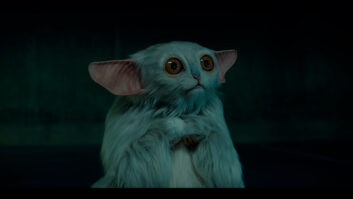This VFX breakdown is from a scene depicting Prototaxites, which lived between 420 and 350 million years ago. Its first fossil was found in 1843, but it was such an unexpected scientific discovery that it took until 2001 for scientists to realise what exactly it was.
At 8 metres high and a metre wide, Prototaxites was the largest land-dwelling organism of its day—taller than any plant—and, most surprisingly, it was discovered to be a type of giant fungi.
While simple plants had only just begun to live on land and didn’t stray far from the water’s edge, this fungi had leapt ahead in the race to colonise the land and had grown to gargantuan sizes.
In this scene, we wanted to create a grand reveal, in which a new day and era is dawning, where these alien-looking prototaxites dominate the landscape. Our intention was to make the scene feel both strange and familiar; it is our planet, but so far in the past that it is almost unrecognisable to the one we know.
The biggest challenge was to make it seem realistic and believable. Initially we were given sketches and illustrations from scientists and the artists they had used. They were rudimentary and varied because the only physical record that remains of prototaxites are fossils, so no one can really say exactly what they looked like. To a certain extent, we had to take an educated guess.
We got lots of reference material of modern-day fungi and discussed it with the BBC science and production teams, then we went through numerous iterations until we landed on the final look. The results not only fitted with the science but also, felt at once familiar and unsettlingly alien.
Obviously, these fungi had grown to be 8 metres tall, so we knew they were sturdy enough that they wouldn’t collapse under their own weight. We also had some indication of what their surface texture was like because this was what had first tipped scientists off that their fossils were from a type of fungus.
We spent a long time considering how best to represent and light this surface texture, because if it was too smooth and without detail then there wouldn’t be anything to give the audience a sense of scale.
Additionally, we contrasted the height of the Prototaxites with other assets in the scene, such as boulders, pebbles and moss, to further visually signpost to the audience how tall they were.
Creating the spores coming from these fruiting fungi was a balancing act because in reality spores are rarely visible to the naked eye, so we used a wind simulation in Houdini to make it seem like they were subtly catching the light of the sun while being carried on a turbulent breeze.
The groundbreaking nature of the work we did on Earth and the fact that our VFX made up more than a third of the series’ overall screen time meant we had a big responsibility to get things right.
There were many creative challenges and luckily also a few firsts; we visualised ancient flora and fauna that has never been imagined in 3D before. The images and footage we made are accurate enough to be used as scientific reference material—it would be great recognition if our work on the series did come to be used that way.
Earth is available to watch on BBC iPlayer, and is currently showing as Ancient Earth in the US on PBS’ science series Nova with the final episode airing November 2nd.







